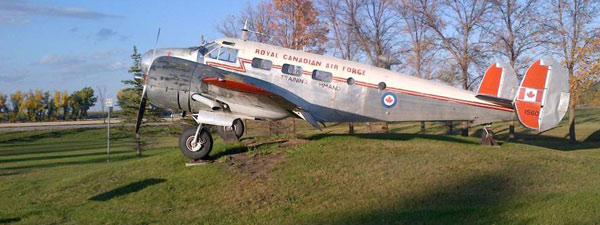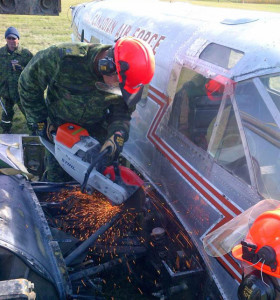Wichita Wiggler new Air Force Museum project
Administrator | Oct 25, 2013 | Comments 0
By Ross Lees
The National Air Force Museum of Canada at 8 Wing Trenton has acquired a Wichita Wiggler and will soon begin preparing it for display.
Perhaps better known in the military as the C-45 Expeditor made by Beechcraft of Wichita, Kansas, aircraft number 1560 may have been called many other things during its flying career – such as the Beech 18, The Expeditor and The Exploder, but it was an important aircraft in the history of the Royal Canadian Air Force (RCAF), according to museum executive director Chris Colton.
“We always wanted to have a C-45 Expeditor on our inventory for our collection because it was a very important aircraft for many, many years in the RCAF,” he said.
Three years ago, Mr. Colton and the museum started searching for one of these aircraft and it originally looked like the assignment might be too easy. There was one in Campbellford, but, unfortunately, the owners wanted money for the aircraft and the museum prefers to trade, or receive as a gift.
Further searching revealed an aircraft with the tail number 1560 at the former CFB RCAF Station Portage, in Portage la Prairie, Manitoba, and after almost two years, and with much negotiation, a deal was struck.
The museum would trade a Tutor for the Wichita Wiggler.
Once the trade was confirmed, Colton contacted the Recovery and Salvage Support (RAS) team at the Aerospace and Telecommunication Engineering Support Squadron (ATESS) and set up the recovery of the Wiggler.
Museum projects are highly regarded by the ATESS RAS team, according to Warrant Officer Jason Houle.
“We’re thrilled to embark on this project,” he said. “This kind of thing keeps our skills honed. We also teach a course because all the bases that have flying assets has a RAS teams, so we’re sort of the subject matter experts.”
While the ATESS RAS team has just five people, other bases like Cold Lake have teams upwards of 18. But, when a major incident occurs, the team from ATESS is often called upon to act as “the subject matter experts” while the home team will provide people power and familiarity with the assets.
Part of the ATESS RAS team that recovered the Wiggler was Paul Botting, the museum’s restoration workshop manager.
It took the RAS team nine days from the time they left CFB Trenton to drive to Portage la Prairie to dismantle the aircraft to the point where they could load it on a flatbed truck and drive it back to Trenton. It took them three days alone to dismantle the aircraft and one additional day to load it on the flatbed.
“It was a challenge on its own,” noted Mr. Botting. “The landing gear is right under the wings so if you cut off the wings to take off the landing gear, the aircraft is going to tip.”
“We had to air-bag the fuselage, take the wings off and bring it down, so it was neat,” adds Houle.
The RAS team felt more comfortable with the salvaging with Mr. Botting along.
“He (Paul) does a lot of these so it was imperative that we just didn’t go crazy with the saws and cut it all apart because that’s extra work for these guys (at the museum in Trenton),” Houle said. “We wanted to make sure we minimized the work for them but that we also managed to get it onto the truck.”
Now the aircraft officially becomes Mr. Botting’s “baby.” While still under wraps at the museum, the team of about 20 volunteers will soon begin repairing it and restoring it to its original luster. Mr. Botting thinks that will take perhaps two to three years to restore, although it will likely take closer to two years since the aircraft is in remarkably good shape.
Even though it was sitting outside for perhaps 30 years, most of the damage it suffered came from lawn mowers, according to the salvage team. They were amazed to find the tires still contained air.
Because the aircraft was just sitting outside, Mr. Colton worried about vandalism but the salvage team said even the interior remained virtually intact. They did, however, find proof that someone had been inside the aircraft fairly recently. A geocaching game was found inside the aircraft with the last date listed as Sept. 14, 2013, just days before the aircraft was moved off-site by the ATESS RAS team.
“We’ll repair any damage that’s on it and all the windows will have to be replaced,” Mr. Botting stated. “The wings will have to be repaired and put back on, then we’ll paint it to its original colours and out it on display. It’s in the best shape of any aircraft we’ve ever got.”
Amazingly, one of the volunteers who will work on the Wiggler actually flew it in Borden and another pilot in Brighton is an ex-Expeditor pilot.
Filed Under: Local News
About the Author:



































